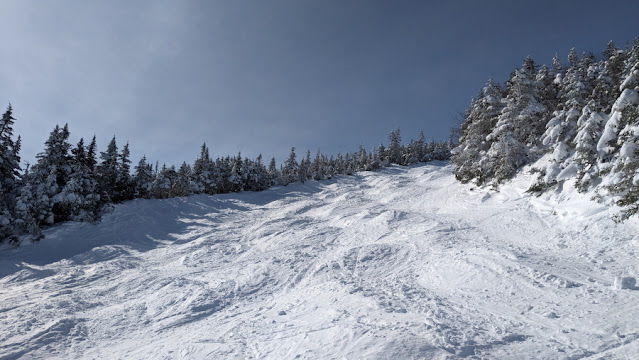Happy Easter!
We are lucky to fit Easter in between late winter snow storms. I was up in Franconia Notch after last weekend's big storm for what I though would be my last powder day of the season - Cannon Mountain is beautiful on a bright winter day.
 |
| Cannon Ski area with the Franconia Range looming behind. |
I don't have a lot of confidence in weather forecasts after the last storm dropped twice as much snow as predicted, but they're forecasting another nice snowfall in the middle of this week, so maybe we'll get one more last powder day of the season.
With both the winter birds and the early migrating birds in the area we had quite a few visitors to the bird feeder which we put back out for a couple of days during and after the snow. There was one very pretty bird on the feeder that I didn't recognize.
It had a long bronze colored tail and sharp markings on its back. I'm embarrassed to say that when I looked it up I found it was a Song Sparrow. I guess they've never shown me their backside before - I've always considered them to be rather plain brown bird, but this perspective taught me to never judge another being until I thoroughly understand it!
We saw plenty of snowbirds, chickadees, goldfinches and mourning doves, as well as more pine siskins, and they all very much enjoying food not buried under the snow. Goldfinches, snowbirds, and pine siskins are plenty happy with the small millet seeds.
 |
| Small birds with small beaks are very happy with small seeds. |
But not the White-breasted Nuthatches.
 |
| No thank you. |
Nuthatches are never satisfied with small seeds - it dropped this rejected morsel down onto the snow for some other bird to have and went back to shovel through the feeder for a seed more to its liking.
 |
| This one will do. |
One of our many beavers came by early enough in the evening for me to get a good picture of it swimming by.
 |
| A large beaver cruising the lake early one evening. |
From what I've read, taking pictures of an eclipse is challenging due to the dramatic changes in light intensity between even a sliver of sun being exposed and the moment of total eclipse, especially when you have only seconds during totality. So I did a little practicing with the sun and the moon. The solar filter is pretty neat, letting me see sun spots on the surface of the sun.
 |
| Sunspots visible with a solar filter that blocks over 99% of the light. |
A new crescent moon a couple of weeks ago showed the challenges of photographing different brightness levels.
Those two pictures are of the same moon just moments apart, but with the first photo exposed to show craters on the crescent of the sunlit surface and the second showing the dark side of the moon. The second photo has a much longer exposure to capture what appears as total blackness in the first picture, but is actually lit up very dimly by light from the sun, reflected off the earth back toward the dark side of the moon, then after hitting the moon being reflected back to earth into my camera. The long exposure means the lit crescent is highly overexposed, and even a few bright stars are visible in the second photo.
All this preparation before an event that might not even be visible in the often cloudy days of April, but if we can see it, it could be a once-in-a-lifetime experience.
But before that happens, maybe there's one more good powder day in store for us?




No comments:
Post a Comment